Effects of Safety Harnesses Protecting against Falls from a Height on the User’s Body in Suspension
Abstract
:1. Introduction
2. State of the Art
- Anatomical features;
- Body dimensions and weight;
- Psycho-physical state;
- The influence of substances such as medications, alcohol, etc.;
- Loss of consciousness due to (e.g., impact against objects while falling from a height).
- Suspension duration;
- Movement impairment during suspension;
- The angle between the user’s torso and the vertical;
- Leg position in suspension;
- Harness fit to the user’s body,
- Harness design, including harness attachment point position;
- Compression of the human body by harness straps and buckles.
3. Study Material
4. Test Method
- The study participants were coached on the test procedure and safety precautions as well as told what they should pay attention to in terms of the effects of the harness on their body.
- The participants were familiarized with the harness; they donned it and the harness was fit to their body according to the manufacturer’s instructions.
- The participants performed several exercises such as forward bends, squats, and jumps to verify harness fit to their body.
- A 2 m long Kevlar rope was attached to the selected attachment point on the harness, with its other end being attached to the hook of a lifting device.
- After the participant’s consent, the lifting device was switched on and the participant was lifted approx. 10–15 cm above floor level.
- The participant remained suspended for 3 min (time was controlled with a stopwatch),
- During the test the participant and the harness were photographed.
- The participant was lowered to the floor and took off the safety harness.
- The participant filled out the questionnaire, thus recording the test results.
- The participant rested for approx. 30 min and performed light physical exercises to restore normal body function.
- Points at which the straps, connecting buckles, attachment points, and other harness elements compressed the participant’s body (the participant was asked to mark those points on a chart);
- The degree of discomfort caused by the pressure of harness elements;
- Any uncomfortable body position forced by the harness;
- Any breathing difficulty;
- Numbness or tingling of body parts;
- Any hindrance to mobility in suspension;
- General comfort in suspension.
5. Study Results
- Photographs of harnesses with points marked by the users as causing discomfort while in suspension;
- Description of the type of harness effect causing discomfort at a given point, such as thigh strap compression of the crotch area;
- Lw parameter representing the number of participants indicating a given point in the harness as causing noticeable discomfort, in relation to the total number of participants;
- W parameter representing the mean perceived degree of discomfort caused at a given point according to the scale presented in Section 4 of the article.
- Compression of the crotch area by the thigh straps. This phenomenon was mostly observed for suspension in harnesses H1, H2, and H3 using both the dorsal (X) and sternal (Y) attachment points. The edges of the thigh straps exerted pressure on the crotch area of the subject causing severe pain, which in one case led to quitting the trial before 3 min. The severity of pain caused by thigh strap compression of the crotch area was significantly lower in the case of harness H3, which featured cushioning pads. This phenomenon was the least pronounced in the case of harness H4, especially when suspended from the ventral attachment point, enabling the subject to adopt a sitting-like position. As a result, the subjects’ thighs remained vertical, while the thigh straps with cushioning pads were loaded across their width. Given literature reports, e.g., in publications [8,9,13,14,15,16,17,18,19,20,21,22,23,24,25,26,27], this phenomenon should be deemed one of the most dangerous in situations of humans being suspended in safety harnesses, as it may lead to serious circulatory disturbances in the legs. This was corroborated by leg numbness in one subject suspended in harness H1.
- Compression of the base of the neck by the shoulder straps. This phenomenon was mostly found for safety harnesses H1, H2, and H4 while using the dorsal (X) attachment point. It was caused by the fact that the shoulder straps were brought closer together at neck level as the dorsal attachment point shifted upwards when the user’s weight acted on the harness. This effect was not reported when sternal (Y) and ventral (Z) attachment points were used.
- Chest compression by the shoulder straps at clavicle level. This phenomenon was found for safety harnesses H1, H2, H3, and H4 while using the dorsal (X) attachment point, which forced the subject to lean forward. The pressure exerted by the shoulder straps on the chest in that position were perceived as very uncomfortable.
- Compression exerted by the sit strap connecting the thigh straps below the buttocks. This phenomenon was found for safety harnesses H2 and H3 while using the sternal (Y) and dorsal (X) attachment points. It was caused by the sit strap moving upwards as the user’s weight acted on the harness. As a result, the sit strap exerted pressure above the buttocks rather than support the user below them. However, compression from the sit strap was not experienced as very uncomfortable.
- Compression exerted by the shoulder and thigh straps crossing at hip level. This phenomenon was found for safety harnesses H2 and H3 while using the sternal (Y) attachment point. Forces acting on the shoulder and thigh straps brought them closer together, thus exerting pressure on the user’s body. Compression from the shoulder and thigh belts crossing at hip level was not perceived by the participants as very uncomfortable.
- Compression of the abdomen and inferior ribs by the waist belt (for positioning). This phenomenon was found for safety harness H4 while using the dorsal (X) attachment point. It was caused by the waist belt being pulled upward (as a result of the user’s body acting on the harness) and by the participant leaning forward due to the use of the dorsal attachment point.
- Posterior spinal hyperextension. This phenomenon was found for safety harness H3 while using the sternal (Y) attachment point. It was caused to the insufficient tensioning of the shoulder straps resulting in the upper part of the user’s back being unsupported. Thus, the participant had to correct his position by muscle contraction while suspended.
6. Summary
- Harness models H1, H2, and H3 in which the shoulder and thigh straps crossed at hip level caused compression of the crotch area while using both dorsal (X) and sternal (Y) attachment points. This phenomenon was also found in a study examining the pressure of thigh straps on an anthropometric dummy [36]. This is caused by the “vertical” orientation of the thigh straps and the resulting compression by the edges of textile straps. Both studies involving human subjects and an anthropometric dummy [36] showed that the use of cushioning pads (as in harness H3) alleviates the problem by reducing compression.
- Harness H4 generated the lowest degree of unacceptable thigh strap compression, especially when the participant was suspended from the ventral attachment point (Z). As that attachment point is situated near the human center of gravity, the user’s thighs were oriented horizontally, while thigh straps with cushioning pads were loaded across their entire width. This phenomenon was also observed in a study of thigh strap compression on the surface of an anthropometric dummy [36].
- In harness models H1, H2, and H4 suspended from the dorsal (X) attachment point, the edges of the shoulder straps exerted pressure on the base of the neck. This was caused by the shoulder straps coming too close together at neck level. From the standpoint of harness design, this resulted either from an inappropriate location of the dorsal attachment point (X) or its upward displacement due to harness loading.
- In some cases of suspension from the dorsal attachment point (X), the shoulder straps of harnesses H1-H4 compressed the front of the chest at clavicle level, which was also noted in paper [36]. In terms of safety harness design, this was attributable to the too low position of the dorsal attachment point (X) and the loosening of the shoulder straps.
- In harness models H2 and H3 compression was exerted by shoulder and thigh straps crossing at hip level when the sternal attachment point (Y) was used. This was caused by the forces acting on the shoulder and thigh straps, which brought them closer together, thus putting pressure on the user’s body. This effect was also reported from a study involving an anthropometric dummy [36].
- In harness H4, the waist belt (for work positioning) compressed the user’s abdomen and inferior ribs when suspended from the dorsal attachment point. This was caused by the upward movement of the waist belt in conjunction with the user leaning forward. From the standpoint of safety harness design, this phenomenon was attributable to excessive elasticity of the harness part (straps) below the waist belt, which was not able to prevent belt shifting under loading.
- Harness H3 suspended from the sternal attachment point (Y) caused the posterior spinal hyperextension of the suspended user. This was attributable to the insufficient tensioning of the shoulder straps and the low position of the attachment point, as a result of which the upper part of the user’s back remained unsupported. Analysis in terms of safety harness design indicates that the problem was caused by the fact that the frontal attachment point was located too close to the user’s center of gravity, as well as by the loosening of the shoulder straps (e.g., by the slippage of the textile straps in adjustment buckles).
7. Conclusions
Funding
Institutional Review Board Statement
Informed Consent Statement
Data Availability Statement
Conflicts of Interest
References
- Państwowa Inspekcja Pracy (PIP). Raport z Działalności Państwowej Inspekcji Pracy w 2021 roku [Report on the Activities of the National Labor Inspectorate in 2021]. PIP: Warszawa, Poland. 2022. Available online: https://www.pip.gov.pl/pl/f/v/269141/Sprawozdanie%20z%20dzialalnosci%20Panstwowej%20Inspekcji%20Pracy%20-%202021.pdf (accessed on 15 December 2022).
- Główny Urząd Statystyczny (GUS). Wypadki Przy Pracy w 2020 r [Accidents at Work in 2020]. GUS: Warszawa, Gdańsk, Poland. 2019. Available online: https://stat.gov.pl/obszary-tematyczne/rynek-pracy/warunki-pracy-wypadki-przy-pracy/wypadki-przy-pracy-w-2020-roku,4,14.html (accessed on 4 November 2022).
- Sulowski, A.C. Fall arresting systems-classification. In Fundamentals of Fall Protection; Sulowski, A.C., Ed.; International Society for Fall Protection: Toronto, ON, Canada, 1991; pp. 285–301. [Google Scholar]
- Sulowski, A.C. Fall arresting systems-selection of equipment. In Fundamentals of Fall Protection; Sulowski, A.C., Ed.; International Society for Fall Protection: Toronto, ON, Canada, 1991; pp. 303–320. [Google Scholar]
- EN 361:2002; Personal Protective Equipment against Falls from a Height–Safety Harnesses. European Committee for Standardization (CEN): Brussels, Belgium, 2002.
- EN 358:2018; Personal Protective Equipment for Positioning during Operation and Prevention of Falls from a Height–Safety Belts and Lanyards for Positioning during Operation or Restriction of Movement. European Committee for Standardization (CEN): Brussels, Belgium, 2018.
- EN 813:2008; Personal Protective Equipment against Falls from a Height–Sit Harnesses. European Committee for Standardization (CEN): Brussels, Belgium, 2008.
- Amphoux, M. Physiopathological aspects of personal equipment for protection against falls. In Fundamentals of Fall Protection; Sulowski, A.C., Ed.; International Society for Fall Protection: Toronto, ON, Canada, 1991; pp. 33–48. [Google Scholar]
- Hearon, B.F.; Brinkley, J.W. Fall arrest and post-fall suspension: Literature review and directions for further research. In Fundamentals of Fall Protection; Sulowski, A.C., Ed.; International Society for Fall Protection: Toronto, ON, Canada, 1991; pp. 123–138. [Google Scholar]
- EN 12277:2015+A1:2018; Mountaineering Equipment-Harnesses-Safety Requirements and Test Methods. European Committee for Standardization (CEN): Brussels, Belgium, 2018.
- Baszczyński, K.; Jachowicz, M. The effect of the use of full body harnesses on their protective properties. Int. J. Occup. Saf. Ergon. 2009, 4, 435–446. [Google Scholar] [CrossRef] [PubMed] [Green Version]
- Noel, G.M.; Ardouin, G.; Archer, P.; Amphoux, M.; Sevin, A. Some aspects of fall protection equipment employed in construction and public works industries. In Fundamentals of Fall Protection; Sulowski, A.C., Ed.; International Society for Fall Protection: Toronto, ON, Canada, 1991; pp. 1–32. [Google Scholar]
- Sulowski, A.C. Residual risk in fall arresting systems. Fall arresting systems–selection of equipment. In Fundamentals of Fall Protection; Sulowski, A.C., Ed.; International Society for Fall Protection: Toronto, ON, Canada, 1991; pp. 321–344. [Google Scholar]
- Toledo, Y.; Ugarte, J.D. Death from orthostatic shock caused by hanging on a rope. In Proceedings of the Second International Conference of Mountain Rescue Doctors, Innsbruck, Austria, 18 November 1972. [Google Scholar]
- Scharfetter, F. Pressure paralysis of the brachial nerves due to hanging on the rope. In Proceedings of the Second International Conference of Mountain Rescue Doctors, Innsbruck, Austria, 18 November 1972. [Google Scholar]
- Flora, G.; Hölzl, H.R. Fatal and non-fatal accidents involving falls into the rope. In Proceedings of the Second International Conference of Mountain Rescue Doctors, Innsbruck, Austria, 18 November 1972. [Google Scholar]
- Patscheider, H. Pathologico-anatomical examination results in the case of death caused by hanging on the rope. In Proceedings of the Second International Conference of Mountain Rescue Doctors, Innsbruck, Austria, 18 November 1972. [Google Scholar]
- Stulinger, W.; Dittrich, P.; Flora, G.; Margreiter, R. Circulatory and renal function changes in test subjects suspended from the upper half of the body. In Proceedings of the Second International Conference of Mountain Rescue Doctors, Innsbruck, Austria, 18 November 1972. [Google Scholar]
- Fodisch, J. Morphological findings in the case of death after hanging on a rope for four hours. In Proceedings of theSecond International Conference of Mountain Rescue Doctors, Innsbruck, Austria, 18 November 1972. [Google Scholar]
- Seddon, P. Harness Suspension: Review and Evaluation of Existing Information; Contract Research Report 451/2002; Health and Safety Executive (HSE): Marsden Huddersfield, UK, 2002. Available online: https://www.hse.gov.uk/research/crr_pdf/2002/crr02451.pdf (accessed on 4 November 2022).
- Madsen, P.; Svendsen, L.B.; Jørgensen, L.G.; Matzen, S.; Jansen, E.; Secher, N.H. Tolerance to head-up tilt and suspension with elevated legs. Aviat. Space Environ. Med. 1998, 69, 781–784. [Google Scholar] [PubMed]
- Bernard, W.; Haselbach, H.; Scharfetter, H.; Aigner, A.; Michaeler, R. Radiological, blood chemistry and lung function findings in the hanging test. In Proceedings of the Second International Conference of Mountain Rescue Doctors, Innsbruck, Austria, 18 November 1972. [Google Scholar]
- Amphoux, M. Hanging after a fall: An extremely urgent rescue. In Proceedings of the International Fall Protection Symposium and Exhibition, Wuppertal, Germany, 15–18 September 1998. [Google Scholar]
- Sheehan, A. Suspension trauma. Techn. Rescue 2000, 27, 16–19. [Google Scholar]
- Damisch, C.; Schauer, N. Wie sicher sind Anseilgurte? [How safe are harnesses?]. Der Bergsteiger, July 1985; 6F–9F. [Google Scholar]
- Dawes, R. Suspension trauma—A medical perspective. Techn. Rsq. 2000, 27, 20. [Google Scholar]
- Lieblich, M.; Rensing, W. Rettung von Abgestürzten und Erste Hilfe nach Hängen im Gurt [Rescuing people who have fallen and first aid following suspension in a safety harness]. ASvorORT 1997, 1, 12. [Google Scholar]
- Viano, D.C.; Parenteau, C.S.; Burnett, R. Influence of standing or seated pelvis on dummy responses in rear impacts. Accid. Anal. Prev. 2012, 45, 423–431. [Google Scholar] [CrossRef] [PubMed]
- Hu, J.; Klinich, K.D.; Reed, M.P.; Kokkolaras, M.; Rupp, J.D. Development and validation of a modified Hybrid-III six-year-old dummy model for simulating submarining in motor-vehicle crashes. Med. Eng. Phys. 2012, 34, 541–551. [Google Scholar] [CrossRef] [PubMed]
- Bartsch, A.; Benzel, E.; Miele, V.; Morr, D.; Prakash, V. Hybrid III anthropomorphic test device (ATD) response to head impacts and potential implications for athletic headgear testing. Accid. Anal. Prev. 2012, 48, 285–291. [Google Scholar] [CrossRef] [PubMed]
- Petrone, N.; Panizzolo, F.; Marcolin, G. Behaviour of an instrumented anthropomorphic dummy during full scale drop tests. Procedia Eng. 2011, 13, 304–309. [Google Scholar] [CrossRef]
- Baszczyński, K. The application of a Hybrid III anthropomorphic dummy in testing personal fall arrest equipment. Meas. Autom. Monit. 2016, 62, 429–433. [Google Scholar]
- Humanetics. Crash Test Dummies. Available online: http://www.humaneticsatd.com/crash-test-dummies (accessed on 4 November 2022).
- Humanetics. Hybrid III 50M Pedestrian. Available online: http://www.humaneticsatd.com/crash-test-dummies/pedestrian/hybrid-iii-50m (accessed on 4 November 2022).
- Tekscan. Pressure Mapping, Force Measurement & Tactile Sensors [Internet]. Available online: https://www.tekscan.com/products-solutions/pressure-mapping-technology (accessed on 4 November 2022).
- Baszczyński, K. Effect of safety harness design on the pressures exerted on the user’s body in the state of its suspension. Int. J. Occup. Saf. Ergon. 2022, 28, 1894–1903. [Google Scholar] [CrossRef] [PubMed]
- Kloß, G.; Ottersbach, H.J. Aufbau von Versuchseinrichtungen für Fallversuche mit einem Gliederdummy [Test Stand for Fall Arrest Tests with an Anthropomorphic Dummy]; Abschlußbericht Nr. 8907112.2 zum Projekt nr. 6042; Fachausschuß Persönliche Schutzausrüstung: Dortmund, Germany, 1993. [Google Scholar]
- FujiFilm. Measuring Pressure, Heat or UV Light Easily with Each Film. Available online: https://www.tekscan.com/sites/default/files/resources/Measurement%20Film%20Catalog%20Brochure.pdf (accessed on 4 November 2022).
- Kloß, G. Biomechanical stress created by personal protective equipment against fall from height. In Proceedings of the International Fall Protection Symposium & Exhibition, Wuppertal, Germany, 15–18 September 1998. [Google Scholar]
- Baszczyński, K. Influence of weather conditions on the performance of energy absorbers and guided type fall arresters on a flexible anchorage line during fall arresting. Saf. Sci. 2004, 42, 519–536. [Google Scholar] [CrossRef]
- Carrión, E.Á.; Saez, P.I.; Pomares, J.C.; Gonzalez, A. Average Force of Deployment and Maximum Arrest Force of Energy Absorbers Lanyards. Int. J. Environ. Res. Public Health 2020, 17, 7647. [Google Scholar] [CrossRef] [PubMed]
- Carrión, E.Á.; Ferrer, B.; Monge, J.F.; Saez, P.I.; Pomares, J.C.; González, A. Minimum Clearance Distance in Fall Arrest Systems with Energy Absorber Lanyards. Int. J. Environ. Res. Public Health 2021, 18, 5823. [Google Scholar] [CrossRef] [PubMed]
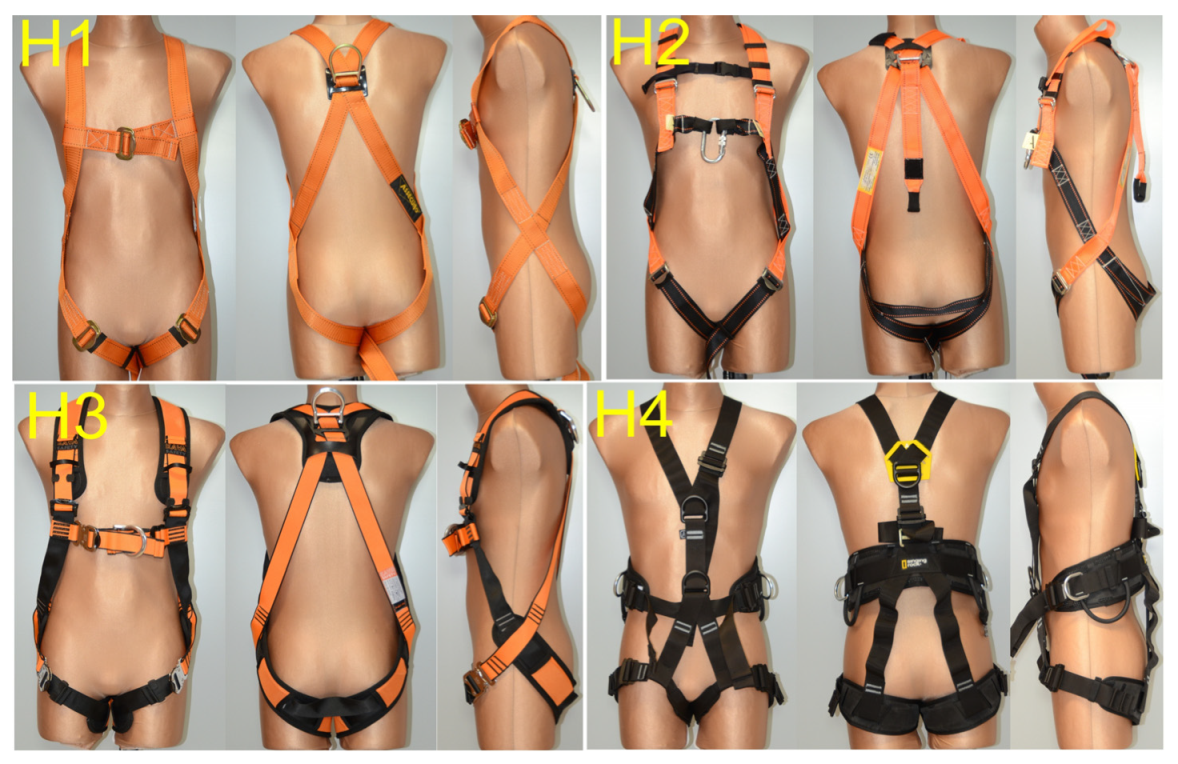
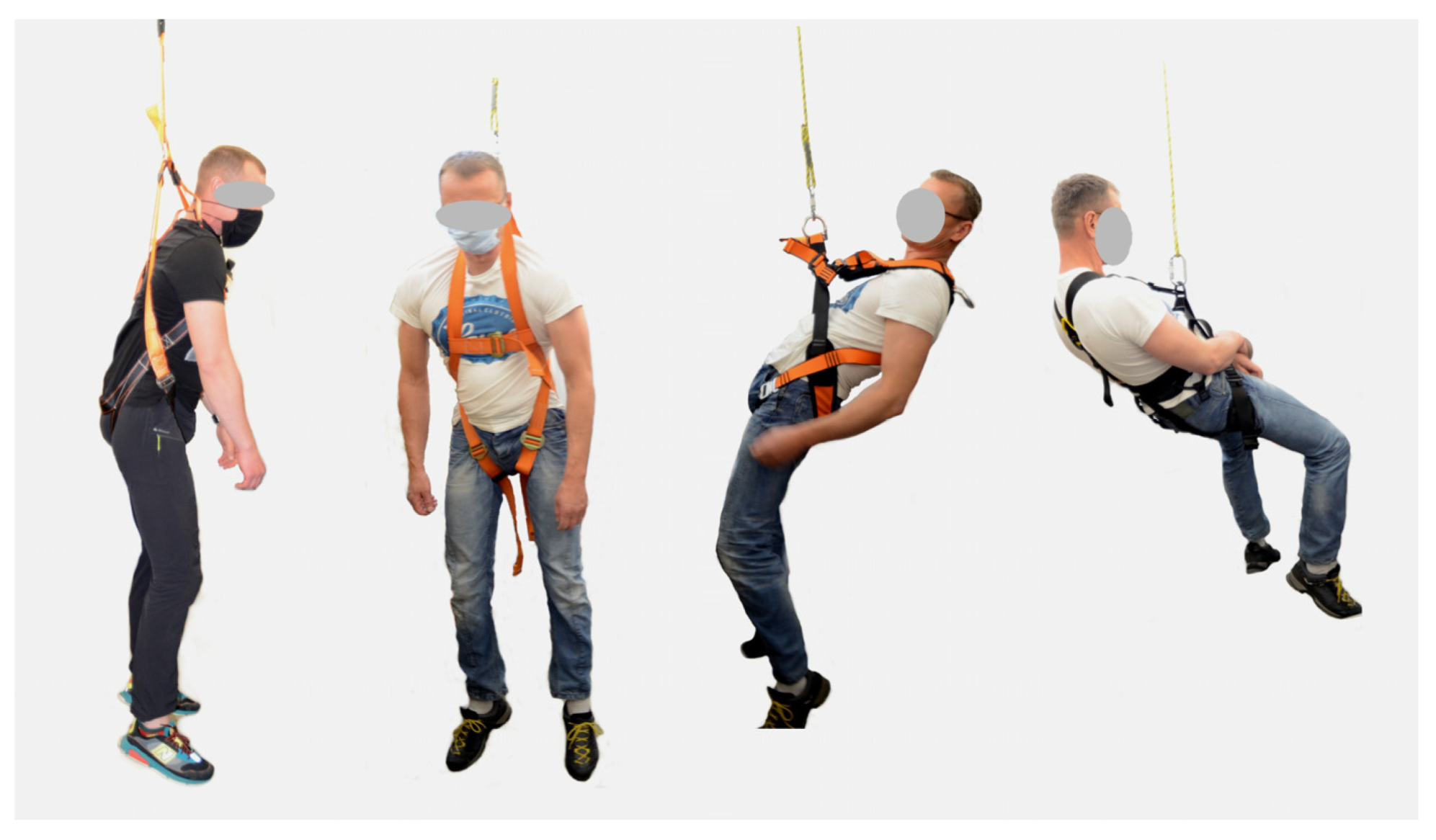
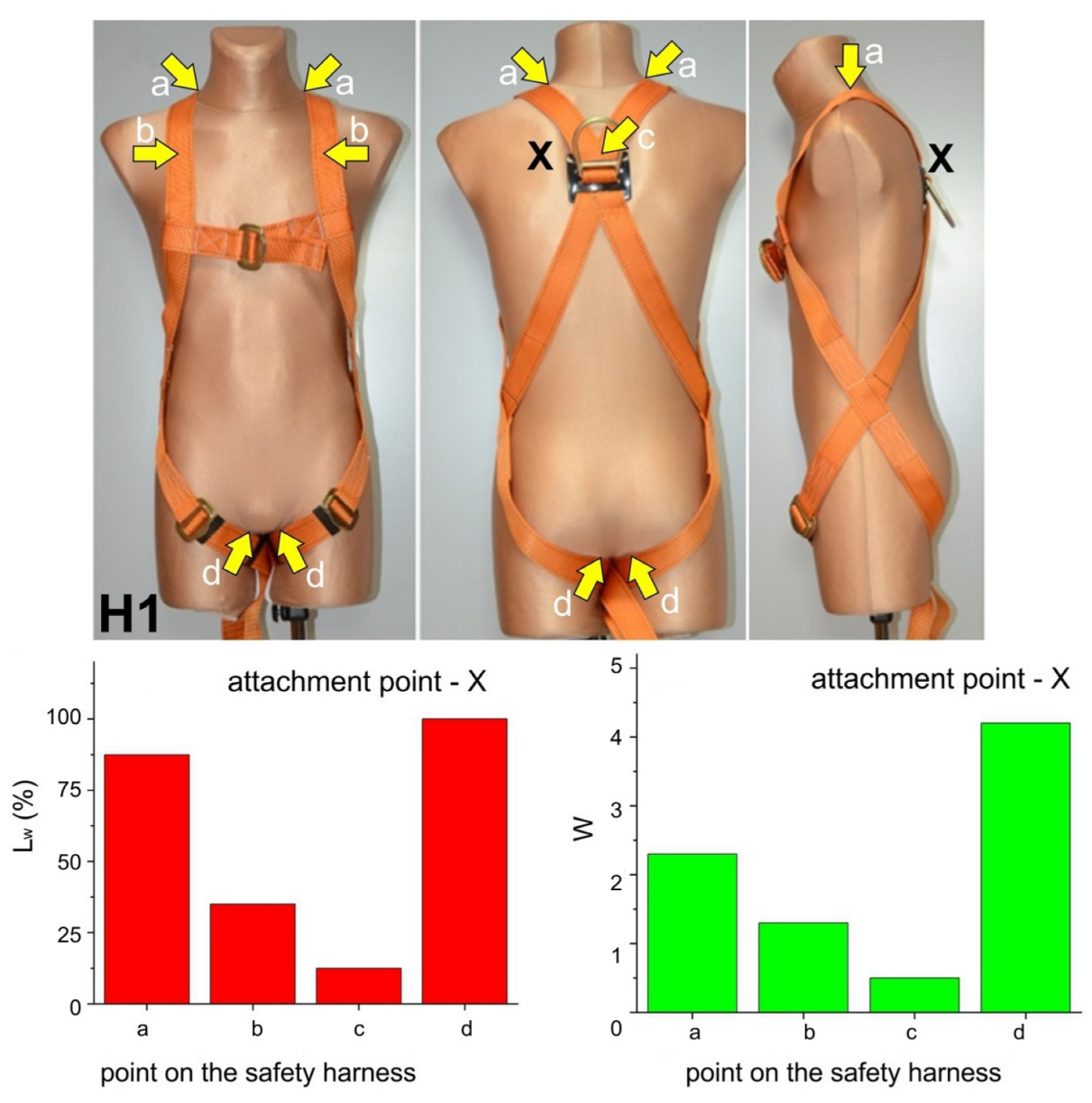
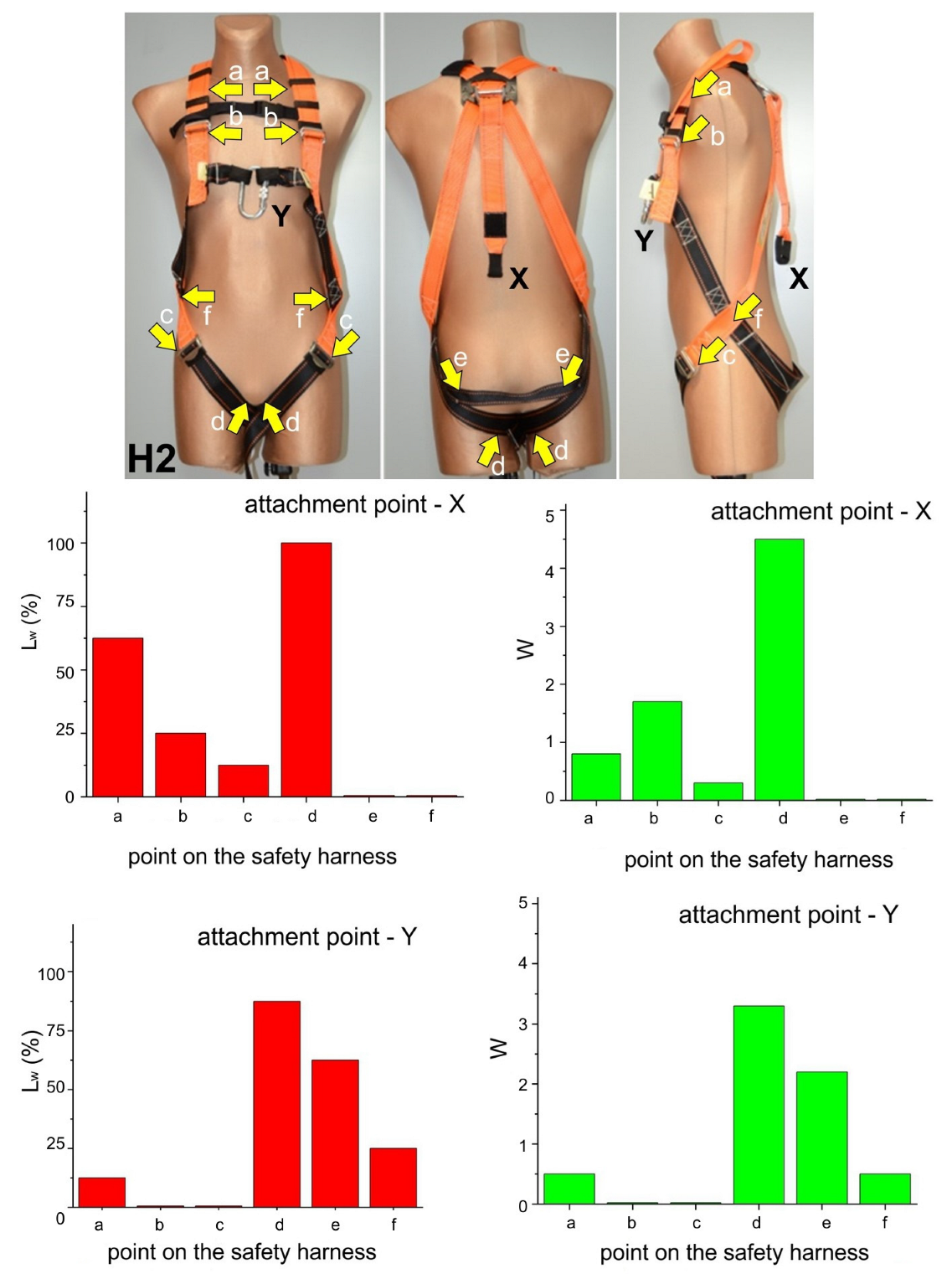

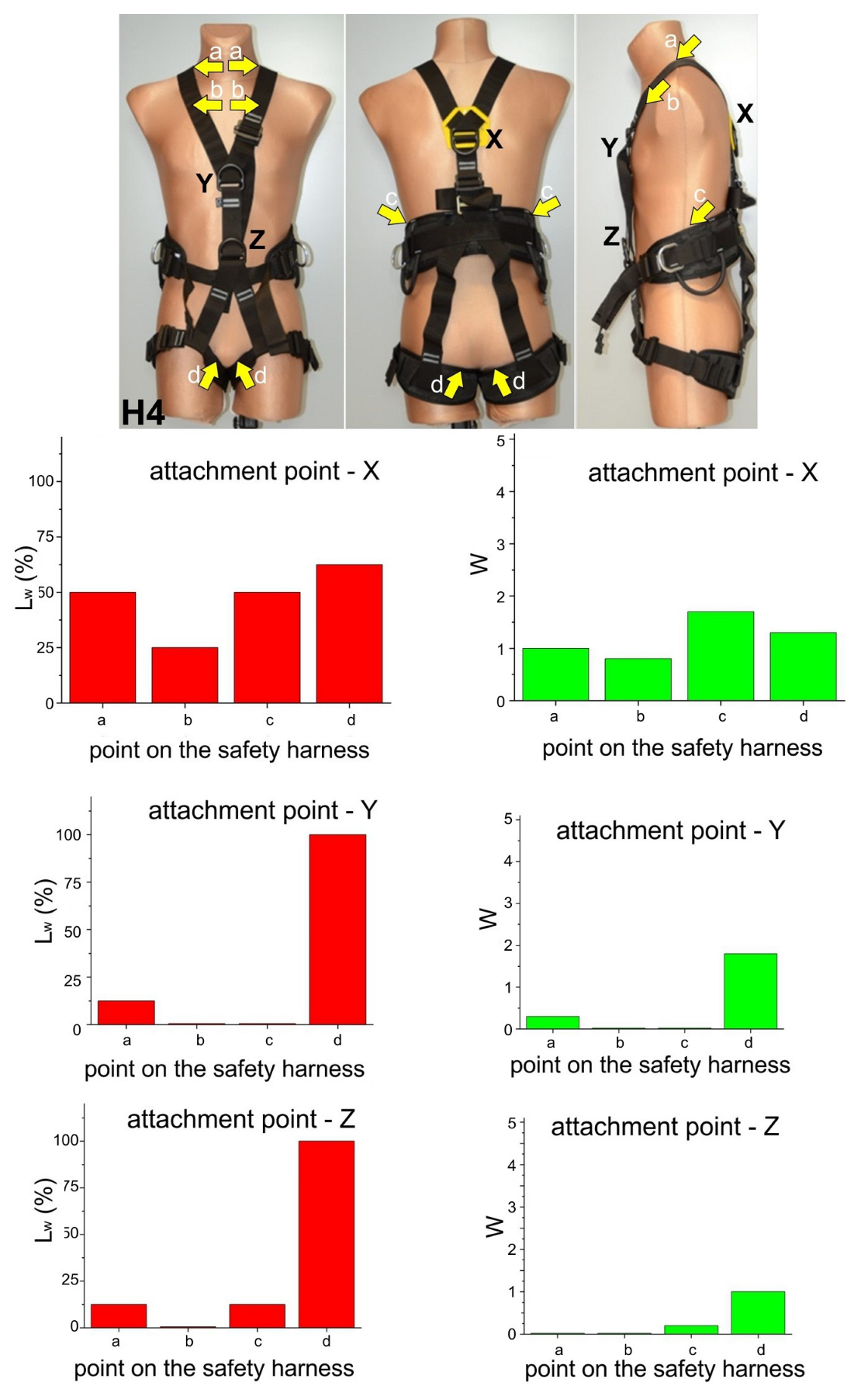
| Symbol | Model | Manufacturer | Attachment Point | Cushioning Pads | Elements for Work Positioning | Other Design Features | ||
|---|---|---|---|---|---|---|---|---|
| Dorsal | Sternal | Ventral | ||||||
| H1 | CA-101 | Assecuro Sp. z o.o., Poland | + | − | − | − | − | Thigh straps crossing at the hip |
| H2 | S-300 | Lubawa S.A., Poland | + | + | − | − | − | Thigh straps crossing at the hip |
| H3 | P451PO | Kaya Safety, Turkey | + | + | − | + | − | Thigh straps crossing at the hip |
| H4 | Technic | Singing Rock s.r.o., Czech Republic | + | + | + | + | work positioning belt | Thigh straps in the form of closed loops |
| Safety Harness | Attachment Point (Symbols as in Figure 3, Figure 4, Figure 5 and Figure 6) | Observation |
|---|---|---|
| H1 | X | • Toe numbness (one case) • Chest compression by shoulder straps (one case) |
| H2 | X | • Suspension time shortened to 2 min due to strong thigh pain caused by compression in the crotch area (one case) |
| Y | • Sit strap shifted above the buttocks (four cases) | |
| H3 | X | • Shoulder straps tightening around the base of the neck (one case) |
| Y | • Spinal pain in the lumbar area due to posterior hyperextension while suspended (three cases) | |
| H4 | X | • Upward shift of the waist strap causing compression of the abdomen and ribs (three cases) |
| Z | • Downward shift of the posterior part of the thigh straps causing discomfort (one case) |
Disclaimer/Publisher’s Note: The statements, opinions and data contained in all publications are solely those of the individual author(s) and contributor(s) and not of MDPI and/or the editor(s). MDPI and/or the editor(s) disclaim responsibility for any injury to people or property resulting from any ideas, methods, instructions or products referred to in the content. |
© 2022 by the author. Licensee MDPI, Basel, Switzerland. This article is an open access article distributed under the terms and conditions of the Creative Commons Attribution (CC BY) license (https://creativecommons.org/licenses/by/4.0/).
Share and Cite
Baszczyński, K. Effects of Safety Harnesses Protecting against Falls from a Height on the User’s Body in Suspension. Int. J. Environ. Res. Public Health 2023, 20, 71. https://doi.org/10.3390/ijerph20010071
Baszczyński K. Effects of Safety Harnesses Protecting against Falls from a Height on the User’s Body in Suspension. International Journal of Environmental Research and Public Health. 2023; 20(1):71. https://doi.org/10.3390/ijerph20010071
Chicago/Turabian StyleBaszczyński, Krzysztof. 2023. "Effects of Safety Harnesses Protecting against Falls from a Height on the User’s Body in Suspension" International Journal of Environmental Research and Public Health 20, no. 1: 71. https://doi.org/10.3390/ijerph20010071




